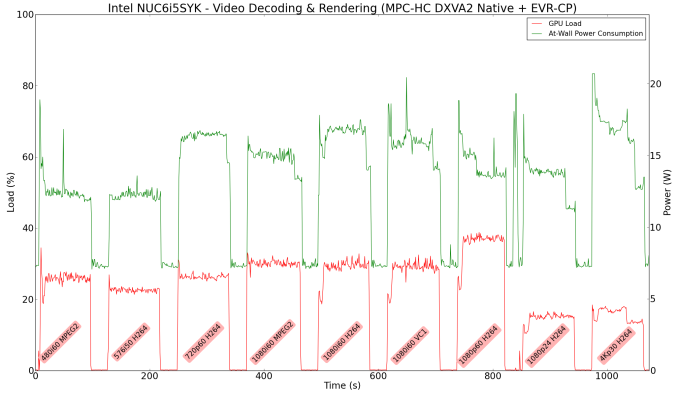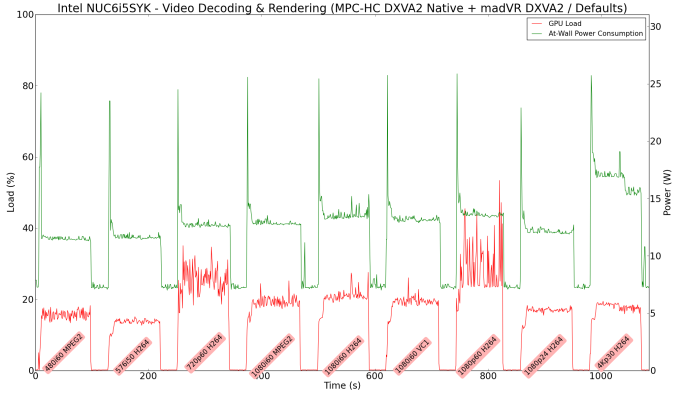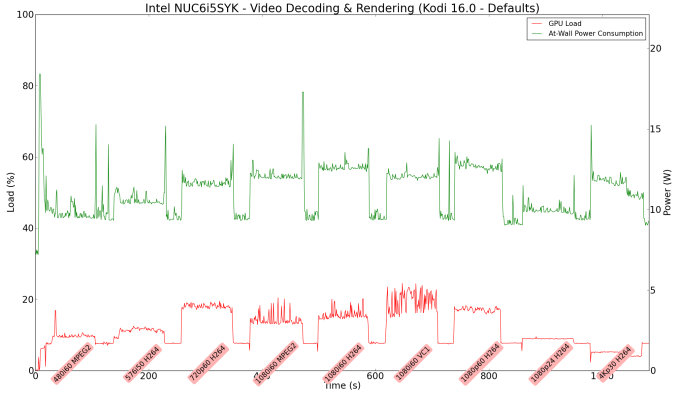The Intel NUC6i5SYK Skylake UCFF PC Review
by Ganesh T S on March 11, 2016 8:00 AM ESTHTPC Credentials
The thermal solution on the NUC6i5SYK is the same as what we have seen in the previous NUCs. Since the Core i5-6260U is a 15W TDP processor, the acoustics are pretty decent (when compared to the fans on the units with 28W TDP processors). Subjectively speaking, the unit is silent for most common HTPC use-cases. Only under heavy CPU / GPU loading (such as stressful madVR configurations) does the fan become audible. Like the previous NUCs, the NUC6i5SYK retains CIR support, enabling use of IR remotes in a home theater setting. The unit definitely makes a good HTPC for folks who don't want to pay the premium for a passively cooled system - however, we didn't find too many improvements over the previous NUCs for HTPC workloads. There is still no HDMI 2.0 / HDCP 2.2 / 4Kp60 HDMI support in the unit.
Refresh Rate Accuracy
Starting with Haswell, Intel, AMD and NVIDIA have been on par with respect to display refresh rate accuracy. The most important refresh rate for videophiles is obviously 23.976 Hz (the 23 Hz setting). As expected, the Intel NUC6i5SYK has no trouble with refreshing the display appropriately in this setting. In fact, the NUC6i5SYK has the most accurate display refresh rates of all the PCs that we have evaluated so far.
The gallery below presents some of the other refresh rates that we tested out. The first statistic in madVR's OSD indicates the display refresh rate.
Network Streaming Efficiency
Evaluation of OTT playback efficiency was done by playing back our standard YouTube test stream and five minutes from our standard Netflix test title. Using HTML5, the YouTube stream plays back a 1080p encoding. Since YouTube now defaults to HTML5 for video playback, we have stopped evaluating Adobe Flash acceleration. Note that only NVIDIA exposes GPU and VPU loads separately. Both Intel and AMD bundle the decoder load along with the GPU load. The following two graphs show the power consumption at the wall for playback of the HTML5 stream in Mozilla Firefox (v 44.0.2).

GPU load was around 24.27% for the YouTube HTML5 stream and barely measurable for the steady state 6 Mbps Netflix streaming case. Note that GPU usage reported by GPU-Z doesn't actually measure the load on the dedicated decoder engines in the GPU.
Netflix streaming evaluation was done using the Windows 10 Netflix app. Manual stream selection is available (Ctrl-Alt-Shift-S) and debug information / statistics can also be viewed (Ctrl-Alt-Shift-D). Statistics collected for the YouTube streaming experiment were also collected here.

Decoding and Rendering Benchmarks
In order to evaluate local file playback, we concentrate on EVR-CP, madVR and Kodi 16.0. We already know that EVR works quite well even with the Intel IGP for our test streams. Under madVR, we used the DXVA2 scaling logic wherever available, and left the rest at default (as it is well known that the stressful configurations don't work even on the Iris Pro-equipped processors). We used the DXVA2 native decoder in the LAV Filters bundled with MPC-HC v1.7.10
In our earlier reviews, we focused on presenting the GPU loading and power consumption at the wall in a table (with problematic streams in bold). Starting with the Broadwell NUC review, we decided to represent the GPU load and power consumption in a graph with dual Y-axes. Nine different test streams of 90 seconds each were played back with a gap of 30 seconds between each of them. The characteristics of each stream are annotated at the bottom of the graph. Note that the GPU usage is graphed in red and needs to be considered against the left axis, while the at-wall power consumption is graphed in green and needs to be considered against the right axis.
Frame drops are evident whenever the GPU load consistently stays above the 85 - 90% mark. The NUC6i5SYK has absolutely no trouble with any of our test streams. Kodi is the most power efficient of the lot, while madVR with DXVA scaling is actually quite power efficient and comparable to EVR-CP.
Moving on to the codec support, the Intel Iris Graphics 540 is a known quantity with respect to the scope of supported hardware accelerated codecs. DXVA Checker serves as a confirmation. Recent driver updates have added VP9 decode support, but, only for 8b encodes.





















95 Comments
View All Comments
Glock24 - Friday, March 11, 2016 - link
Performance is decent, but the risk of bricking it is too high when updating the BIOS. Maybe the updated competing products will do better.yuhong - Friday, March 11, 2016 - link
The problems occur only with SK Hynix DDR4 chips using an older BIOS. Avoid these sticks and you should be fine.Zingam - Sunday, March 13, 2016 - link
Why is there a risk of bricking the NUC when attempting such trivial operation?yuhong - Sunday, March 13, 2016 - link
Because the processor was hanging while doing the BIOS flash operation due to a DRAM timing issue.CajunArson - Friday, March 11, 2016 - link
You say "Iris Graphics" and then you say that these parts have eDRAM but that's not always true.Intel has numerous models that have "Iris Graphics" with the largest (GT3) IGP configuration but do not include the eDRAM. Instead, Iris *Pro* Graphics has been used to designate the use of eDRAM. Do you have confirmation from Intel that this has changed or does the article need correction?
CajunArson - Friday, March 11, 2016 - link
As a followup:Here's the ARK page for that i5 chip: http://ark.intel.com/products/91160/Intel-Core-i5-...
Note "Iris Graphics 540"
Now here's the page for the i7-5775C, which we know actually has the eDRAM in it: http://ark.intel.com/products/88040/Intel-Core-i7-...
Note it lists "Iris Pro Graphics 6200"
Ian Cutress - Friday, March 11, 2016 - link
Intel graphics comes as HD, Iris and Iris Pro.For Skylake, both Iris and Iris Pro use eDRAM:
HD covers all 2+2 and 4+2 configurations (GT1 and GT2),
Iris is 2+3e (GT3e) with 64MB of eDRAM and
Iris Pro is 4+4e (GT4e) with 128MB of eDRAM.
From our Skylake microarchitecture piece:
http://images.anandtech.com/doci/9582/9%20-%20Scal...
Obligatory Wiki link, where AnandTech is the source using Intel slides:
https://en.wikipedia.org/wiki/Intel_HD_and_Iris_Gr...
I'm more than happy to be proved wrong, if there's a GT3 without eDRAM.
CajunArson - Friday, March 11, 2016 - link
OK, it looks like Intel has changed its naming conventions for Skylake.For example, both of those Broadwell NUCs have "Iris" 6100 GPUs, but they lack the eDRAM.
It looks like Intel is pushing eDRAM into more models now, which is a good thing.
firewall597 - Friday, March 11, 2016 - link
"My bad" are the words you are looking for.dsumanik - Friday, March 11, 2016 - link
lol @ nerd fights, i vote you both lose